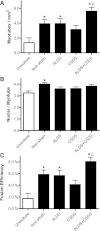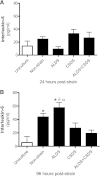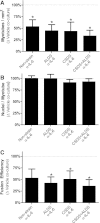Mechanical strain applied to human fibroblasts differentially regulates skeletal myoblast differentiation
- PMID: 22678963
- PMCID: PMC3426169
- DOI: 10.1152/japplphysiol.01545.2011
Mechanical strain applied to human fibroblasts differentially regulates skeletal myoblast differentiation
Abstract
Cyclic short-duration stretches (CSDS) such as those resulting from repetitive motion strain increase the risk of musculoskeletal injury. Myofascial release is a common technique used by clinicians that applies an acyclic long-duration stretch (ALDS) to muscle fascia to repair injury. When subjected to mechanical strain, fibroblasts within muscle fascia secrete IL-6, which has been shown to induce myoblast differentiation, essential for muscle repair. We hypothesize that fibroblasts subjected to ALDS following CSDS induce myoblast differentiation through IL-6. Fibroblast conditioned media and fibroblast-myoblast cocultures were used to test fibroblasts' ability to induce myoblast differentiation. The coculture system applies strain to fibroblasts only but still allows for diffusion of potential differentiation mediators to unstrained myoblasts on coverslips. To determine the role of IL-6, we utilized myoblast unicultures ± IL-6 (0-100 ng/ml) and cocultures ± α-IL-6 (0-200 μg/ml). Untreated uniculture myoblasts served as a negative control. After 96 h, coverslips (n = 6-21) were microscopically analyzed and quantified by blinded observer for differentiation endpoints: myotubes per square millimeter (>3 nuclei/cell), nuclei/myotube, and fusion efficiency (%nuclei within myotubes). The presence of fibroblasts and fibroblast conditioned media significantly enhanced myotube number (P < 0.05). However, in coculture, CSDS applied to fibroblasts did not reproduce this effect. ALDS following CSDS increased myotube number by 78% and fusion efficiency by 96% vs. CSDS alone (P < 0.05). Fibroblasts in coculture increase IL-6 secretion; however, IL-6 secretion did not correlate with enhanced differentiation among strain groups. Exogenous IL-6 in myoblast uniculture failed to induce differentiation. However, α-IL-6 attenuated differentiation in all coculture groups (P < 0.05). Fibroblasts secrete soluble mediators that have profound effects on several measures of myoblast differentiation. Specific biophysical strain patterns modify these outcomes, and suggest that myofascial release after repetitive strain increases myoblast differentiation and thus may improve muscle repair in vivo. Neutralization of IL-6 in coculture significantly reduced differentiation, suggesting fibroblast-IL-6 is necessary but not sufficient in this process.
Figures







Similar articles
-
Biomechanical strain vehicles for fibroblast-directed skeletal myoblast differentiation and myotube functionality in a novel coculture.Am J Physiol Cell Physiol. 2014 Oct 15;307(8):C671-83. doi: 10.1152/ajpcell.00335.2013. Am J Physiol Cell Physiol. 2014. PMID: 25122874 Free PMC article.
-
Fibroblasts influence muscle progenitor differentiation and alignment in contact independent and dependent manners in organized co-culture devices.Biomed Microdevices. 2013 Feb;15(1):161-9. doi: 10.1007/s10544-012-9709-9. Biomed Microdevices. 2013. PMID: 22983793 Free PMC article.
-
Osteopontin expression in coculture of differentiating rat fetal skeletal fibroblasts and myoblasts.In Vitro Cell Dev Biol Anim. 2006 Jan-Feb;42(1-2):4-7. doi: 10.1007/s11626-006-0003-0. In Vitro Cell Dev Biol Anim. 2006. PMID: 16618210
-
Cell fusion in skeletal muscle--central role of NFATC2 in regulating muscle cell size.Cell Cycle. 2003 Sep-Oct;2(5):420-3. Cell Cycle. 2003. PMID: 12963831 Review.
-
Regulation of Skeletal Muscle Myoblast Differentiation and Proliferation by Pannexins.Adv Exp Med Biol. 2017;925:57-73. doi: 10.1007/5584_2016_53. Adv Exp Med Biol. 2017. PMID: 27518505 Review.
Cited by
-
Mechanical stimulation of human dermal fibroblasts regulates pro-inflammatory cytokines: potential insight into soft tissue manual therapies.BMC Res Notes. 2020 Aug 27;13(1):400. doi: 10.1186/s13104-020-05249-1. BMC Res Notes. 2020. PMID: 32854782 Free PMC article.
-
Engineered Human Contractile Myofiber Sheets as a Platform for Studies of Skeletal Muscle Physiology.Sci Rep. 2018 Sep 17;8(1):13932. doi: 10.1038/s41598-018-32163-1. Sci Rep. 2018. PMID: 30224737 Free PMC article.
-
Clinical and symptomatological reflections: the fascial system.J Multidiscip Healthc. 2014 Sep 18;7:401-11. doi: 10.2147/JMDH.S68308. eCollection 2014. J Multidiscip Healthc. 2014. PMID: 25258540 Free PMC article.
-
Mechanisms Underlying Anti-Inflammatory and Anti-Cancer Properties of Stretching-A Review.Int J Mol Sci. 2022 Sep 4;23(17):10127. doi: 10.3390/ijms231710127. Int J Mol Sci. 2022. PMID: 36077525 Free PMC article. Review.
-
Feeder-supported in vitro exercise model using human satellite cells from patients with sporadic inclusion body myositis.Sci Rep. 2022 Jan 20;12(1):1082. doi: 10.1038/s41598-022-05029-w. Sci Rep. 2022. PMID: 35058512 Free PMC article.
References
-
- Al-Khalili L, Bouzakri K, Glund S, Lonnqvist F, Koistinen HA, Krook A. Signaling specificity of interleukin-6 action on glucose and lipid metabolism in skeletal muscle. Mol Endocrinol 20: 3364–3375, 2006 - PubMed
-
- Andersson GB, Lucente T, Davis AM, Kappler RE, Lipton JA, Leurgans S. A comparison of osteopathic spinal manipulation with standard care for patients with low back pain. N Engl J Med 341: 1426–1431, 1999 - PubMed
-
- Badylak SF. The extracellular matrix as a scaffold for tissue reconstruction. Semin Cell Dev Biol 13: 377–383, 2002 - PubMed
Publication types
MeSH terms
Substances
LinkOut - more resources
Full Text Sources

